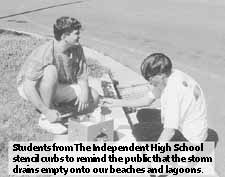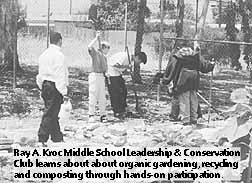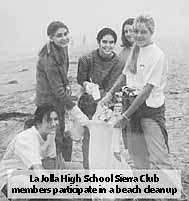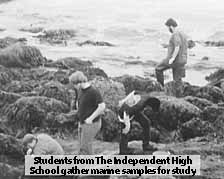






Environmental programs in our schools
by Lorin Hallinan
 ore than ever before, children and teens are getting
involved in preserving and protecting the Earth. They're forming ecology
clubs. They're recycling. They're cleaning up beaches and studying lagoons.
They're protecting endangered species. Best of all, they're spreading the
word.
ore than ever before, children and teens are getting
involved in preserving and protecting the Earth. They're forming ecology
clubs. They're recycling. They're cleaning up beaches and studying lagoons.
They're protecting endangered species. Best of all, they're spreading the
word.
 Thanks to a number of hands-on environmental education
programs in San Diego, kids today are becoming leaders for tomorrow in the
fight to preserve and protect the globe.
Thanks to a number of hands-on environmental education
programs in San Diego, kids today are becoming leaders for tomorrow in the
fight to preserve and protect the globe.
 What follows is a glimpse of some of the numerous educational
programs provided by schools and private organizations around the county
that are sharpening kids' environmental smarts.
What follows is a glimpse of some of the numerous educational
programs provided by schools and private organizations around the county
that are sharpening kids' environmental smarts.
Building awareness
 Water's common theme in science has inspired children
in the San Diego Unified School District to take notice of water quality.
"Kids are interested in clean water," said Dr. Vance Mills, the
district's mathematics and science program coordinator. "Younger kids
are the generation who will take much better care of the environment and
are concerned about it. They realize this planet is theirs, and if we're
not careful with it, they're going to inherit even worse than what we have
now."
Water's common theme in science has inspired children
in the San Diego Unified School District to take notice of water quality.
"Kids are interested in clean water," said Dr. Vance Mills, the
district's mathematics and science program coordinator. "Younger kids
are the generation who will take much better care of the environment and
are concerned about it. They realize this planet is theirs, and if we're
not careful with it, they're going to inherit even worse than what we have
now."
 Although environmental education is not required in
the district's 155 schools, it is recommended within the California Science
Framework. Mills said a new science program in kindergarten through eighth
grades integrates science and social studies. There also are more hands-on
programs, not merely talks about the ozone layer.
Although environmental education is not required in
the district's 155 schools, it is recommended within the California Science
Framework. Mills said a new science program in kindergarten through eighth
grades integrates science and social studies. There also are more hands-on
programs, not merely talks about the ozone layer.
 Dr. Susan Bentley, assistant superintendent in the Carlsbad
Unified School District, has seen a lot of changes since she started in
the district 24 years ago as a science teacher. "As I go through the
schools I see a lot of awareness on the part of the teachers. They're integrating
awareness and respect for the earth in their activities," said Bentley.
"When I talk to the youngsters, they've very much aware of the need
to recycle, and they're learning about gardens that do not use chemicals."
Dr. Susan Bentley, assistant superintendent in the Carlsbad
Unified School District, has seen a lot of changes since she started in
the district 24 years ago as a science teacher. "As I go through the
schools I see a lot of awareness on the part of the teachers. They're integrating
awareness and respect for the earth in their activities," said Bentley.
"When I talk to the youngsters, they've very much aware of the need
to recycle, and they're learning about gardens that do not use chemicals."

Magnet school hits the shore
 The sea turtles weigh only three pounds when they arrive,
but by the time they leave, they've fattened up to a robust 35 pounds.
The sea turtles weigh only three pounds when they arrive,
but by the time they leave, they've fattened up to a robust 35 pounds.
 Thirteen-hundred kids from preschool to sixth grade
at Emerson/Bandini Elementary School in San Diego are benefiting from the
magnet school's marine science focus. "Kids love it because it is such
a unique subject," said Barbara Witzell, a magnet resource teacher
at the school. "We've raised four endangered Atlantic loggerhead sea
turtles and sent three back to the ocean."
Thirteen-hundred kids from preschool to sixth grade
at Emerson/Bandini Elementary School in San Diego are benefiting from the
magnet school's marine science focus. "Kids love it because it is such
a unique subject," said Barbara Witzell, a magnet resource teacher
at the school. "We've raised four endangered Atlantic loggerhead sea
turtles and sent three back to the ocean."
 It takes up to a year to raise the turtles from babies
to 35 pounds. Because they're fed a diet of dead fish while in captivity,
the turtles are sent to Mississippi after they leave the school so they
can learn how to catch live fish. Then they're returned to the islands off
the Georgia coast, where they were born. "Three years ago, it became
illegal to hunt the sea turtles in Mexico, but they still do it," said
Witzell. "They eat the meat, make beauty and leather products out of
them. We're helping kids bring the knowledge to their homes that it shouldn't
be done."
It takes up to a year to raise the turtles from babies
to 35 pounds. Because they're fed a diet of dead fish while in captivity,
the turtles are sent to Mississippi after they leave the school so they
can learn how to catch live fish. Then they're returned to the islands off
the Georgia coast, where they were born. "Three years ago, it became
illegal to hunt the sea turtles in Mexico, but they still do it," said
Witzell. "They eat the meat, make beauty and leather products out of
them. We're helping kids bring the knowledge to their homes that it shouldn't
be done."
 All grade levels study the biology, physiology and human
interaction components of marine science. Field trips are taken and two
weeks of every quarter are spent doing lab work.
All grade levels study the biology, physiology and human
interaction components of marine science. Field trips are taken and two
weeks of every quarter are spent doing lab work.
 Each grade level focuses on a different habitat. Kindergartners
and first graders study the rocky seashore; second graders study sandy beaches;
third graders focus on mudslides and marshes; fourth graders study the kelp
forest; fifth graders explore the wonders of the open ocean; and sixth graders
investigate coral reefs.
Each grade level focuses on a different habitat. Kindergartners
and first graders study the rocky seashore; second graders study sandy beaches;
third graders focus on mudslides and marshes; fourth graders study the kelp
forest; fifth graders explore the wonders of the open ocean; and sixth graders
investigate coral reefs.
 The school pairs with Sea World in its Partner in Education
program, and Sea World helps the school develop its curriculum.
The school pairs with Sea World in its Partner in Education
program, and Sea World helps the school develop its curriculum.

Saving salmon, protecting trout
 Where have all the salmon gone? That's what Robert La
Rosa would like to know as he parodies the popular song of the '70s with
his banjo, giving talks to schools, Rotary and Kiwanis Clubs.
Where have all the salmon gone? That's what Robert La
Rosa would like to know as he parodies the popular song of the '70s with
his banjo, giving talks to schools, Rotary and Kiwanis Clubs.
 Wild trout and coho salmon used to literally choke streams
in San Diego County and Baja, he said. Not anymore. The fish have been systematically
caught in the Tijuana and Santa Margarita rivers and all smaller streams
in between as late as the 1950s, according to La Rosa.
Wild trout and coho salmon used to literally choke streams
in San Diego County and Baja, he said. Not anymore. The fish have been systematically
caught in the Tijuana and Santa Margarita rivers and all smaller streams
in between as late as the 1950s, according to La Rosa.
 The breeds' near extinction had him so concerned, it
led him to give up his own interests and use his skills as an artist, educator
and musician. The result: founding of The Nature School in May 1993.
The breeds' near extinction had him so concerned, it
led him to give up his own interests and use his skills as an artist, educator
and musician. The result: founding of The Nature School in May 1993.
 The non-profit ecology education academy in Ocean Beach
and Soquel, in Santa Cruz County, was co-founded with Gloria Carrillo. The
academy offers hands-on education programs at schools in San Diego County
and conducts stream restoration projects along California's central coastline,
under the auspices of the California Department of Fish and Game.
The non-profit ecology education academy in Ocean Beach
and Soquel, in Santa Cruz County, was co-founded with Gloria Carrillo. The
academy offers hands-on education programs at schools in San Diego County
and conducts stream restoration projects along California's central coastline,
under the auspices of the California Department of Fish and Game.
 The programs include stream exploration and sample collection.
Students also study books, pamphlets, videos, specimens, stuffed fish and
live fish kept in a 40-gallon aquarium. They even get to watch baby trout,
called fry, hatch. "When kids see fish emerge from gravel, they're
besides themselves," said La Rosa.
The programs include stream exploration and sample collection.
Students also study books, pamphlets, videos, specimens, stuffed fish and
live fish kept in a 40-gallon aquarium. They even get to watch baby trout,
called fry, hatch. "When kids see fish emerge from gravel, they're
besides themselves," said La Rosa.
 La Rosa hopes to raise more money so that The Nature
School programs can continue in full force. It costs from $3,000 to $7,000
to develop and present the programs to schools and clubs.
La Rosa hopes to raise more money so that The Nature
School programs can continue in full force. It costs from $3,000 to $7,000
to develop and present the programs to schools and clubs.
The Nature School's basic stream ecology program involves $350 worth of
teaching aids and a $1,000 aquarium. "We've been requested by 30 schools
to bring out our programs," said La Rosa. "I think we'll achieve
enough of our goal to bring it to five or 10 schools this fall."
 Inner city schools, such as Memorial Academy and Emerson/Bandini
Elementary School in San Diego, have benefited from The Nature School's
programs. "We feel that kids in the barrio are plain closer to the
earth," said Rosa. "Here's an opportunity to instill a sense of
confidence and accomplishment in them."
Inner city schools, such as Memorial Academy and Emerson/Bandini
Elementary School in San Diego, have benefited from The Nature School's
programs. "We feel that kids in the barrio are plain closer to the
earth," said Rosa. "Here's an opportunity to instill a sense of
confidence and accomplishment in them."

Clubs create unity
 Global concern prompted students to start an ecology
club at the Winston School, a private school of first- through 12th-graders
in Del Mar. Sponsored by teacher Dale Alrich, the club meets on campus daily
for 45 minutes, but its influence isn't limited to school grounds.
Global concern prompted students to start an ecology
club at the Winston School, a private school of first- through 12th-graders
in Del Mar. Sponsored by teacher Dale Alrich, the club meets on campus daily
for 45 minutes, but its influence isn't limited to school grounds.
 The kids volunteer for I Love a Clean San Diego County
Inc. They clean up Del Mar State Beach. Kids worked with the student council
and organized a campus clean-up. They even raised money to purchase one
acre of land in the Rain Forest to be used for butterfly farms. "We
want to get children more aware of the environment," said club member
Jason Aussie, 17, a senior. "I'm more aware. At home, we recycle cans
and newspapers and we didn't do it before."
The kids volunteer for I Love a Clean San Diego County
Inc. They clean up Del Mar State Beach. Kids worked with the student council
and organized a campus clean-up. They even raised money to purchase one
acre of land in the Rain Forest to be used for butterfly farms. "We
want to get children more aware of the environment," said club member
Jason Aussie, 17, a senior. "I'm more aware. At home, we recycle cans
and newspapers and we didn't do it before."
 This year, Winston won a first place award for beach
clean-up in the Environmental Awareness Program, sponsored by I Love a Clean
San Diego County Inc. They beat out La Jolla High School, who won first
place in 1991 and 1992.
This year, Winston won a first place award for beach
clean-up in the Environmental Awareness Program, sponsored by I Love a Clean
San Diego County Inc. They beat out La Jolla High School, who won first
place in 1991 and 1992.
 "[The science department] works very hard to educate
the children," said Mary Sterling-Torretti, director of the upper school
division. "If the kids hear something on the news, they come in and
talk about it and ask questions, especially in the area of the ocean and
pollution." Students have taken water samples from the ocean and studied
the effect of pollution on the environment.
"[The science department] works very hard to educate
the children," said Mary Sterling-Torretti, director of the upper school
division. "If the kids hear something on the news, they come in and
talk about it and ask questions, especially in the area of the ocean and
pollution." Students have taken water samples from the ocean and studied
the effect of pollution on the environment.

Small, but mighty
 With a student body of just 30, you'd expect a subtle
influence. That's not the case with The Independent High Schools (formerly
North Coast Independent High Schools) in Encinitas, founded in 1991. At
least 20 percent of its regular academic curriculum is environment related.
With a student body of just 30, you'd expect a subtle
influence. That's not the case with The Independent High Schools (formerly
North Coast Independent High Schools) in Encinitas, founded in 1991. At
least 20 percent of its regular academic curriculum is environment related.
 Students go out and clean up area beaches and lagoon
trails. Their efforts won them a second place coastal clean-up award in
the Environmental Awareness Program, sponsored by I Love a Clean San Diego
Inc. "Anything you find in the grocery store, you find in the lagoon,"
said Paul Brice, 17, a junior at the school. "People throw things in
the ocean, too, like beer cans, Coke cans, Zip-lock bags. I want to maintain
the environment because of the destruction that happens because of ignorance."
Students go out and clean up area beaches and lagoon
trails. Their efforts won them a second place coastal clean-up award in
the Environmental Awareness Program, sponsored by I Love a Clean San Diego
Inc. "Anything you find in the grocery store, you find in the lagoon,"
said Paul Brice, 17, a junior at the school. "People throw things in
the ocean, too, like beer cans, Coke cans, Zip-lock bags. I want to maintain
the environment because of the destruction that happens because of ignorance."
 Starting this fall, students will use test kits and
incubators to study soil and water samples. If quality falls below acceptable
standards, students will notify authorities to take action.
Starting this fall, students will use test kits and
incubators to study soil and water samples. If quality falls below acceptable
standards, students will notify authorities to take action.
 While some classes are held by the water, others hit
the trail. Appreciation hikes get the kids out in the lagoon and surrounding
areas. "One of the reasons we want to take care of this is because
we love to hike in it," said Stuart Grauer, director of the school
and a humanities teacher. "The lagoon, associated rivers and beaches
are magnificent." The school keeps a collector's permit and "borrows"
marine mammals and tiny invertebrates for study, then returns them back
to the habitat.
While some classes are held by the water, others hit
the trail. Appreciation hikes get the kids out in the lagoon and surrounding
areas. "One of the reasons we want to take care of this is because
we love to hike in it," said Stuart Grauer, director of the school
and a humanities teacher. "The lagoon, associated rivers and beaches
are magnificent." The school keeps a collector's permit and "borrows"
marine mammals and tiny invertebrates for study, then returns them back
to the habitat.
 If you've ever noticed stenciling painted on storm drains
in Cardiff-by-the-Sea, Encinitas and the San Elijo Lagoon, it may the work
of students at the Independent High Schools. With supplies donated by the
Surfrider Foundation, students paint stencils of dolphins alongside such
phrases as "Don't dump!" and "I live downstream!" to
fend off dumping of anything down the drains. Twice a year students take
fields trips to places such as Yosemite, Catalina Island, the Sea of Cortez,
Colorado, Utah and other areas.
If you've ever noticed stenciling painted on storm drains
in Cardiff-by-the-Sea, Encinitas and the San Elijo Lagoon, it may the work
of students at the Independent High Schools. With supplies donated by the
Surfrider Foundation, students paint stencils of dolphins alongside such
phrases as "Don't dump!" and "I live downstream!" to
fend off dumping of anything down the drains. Twice a year students take
fields trips to places such as Yosemite, Catalina Island, the Sea of Cortez,
Colorado, Utah and other areas. 
 "They face
challenges and it heightens their awareness of the environment," said
Grauer. "It prepares students for college and the world."
"They face
challenges and it heightens their awareness of the environment," said
Grauer. "It prepares students for college and the world."
 Certainly, students in San Diego are getting more opportunities
to care for the Earth. As long as the environment cries out for help, the
opportunities will never end.
Certainly, students in San Diego are getting more opportunities
to care for the Earth. As long as the environment cries out for help, the
opportunities will never end.









